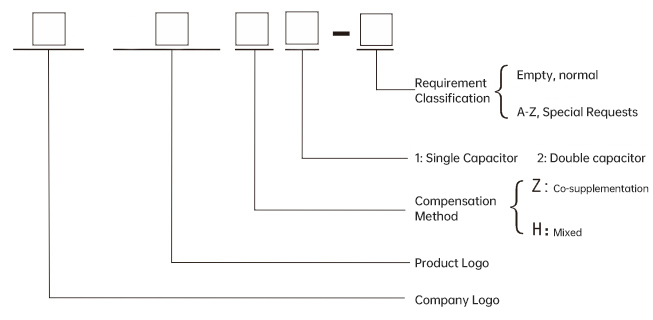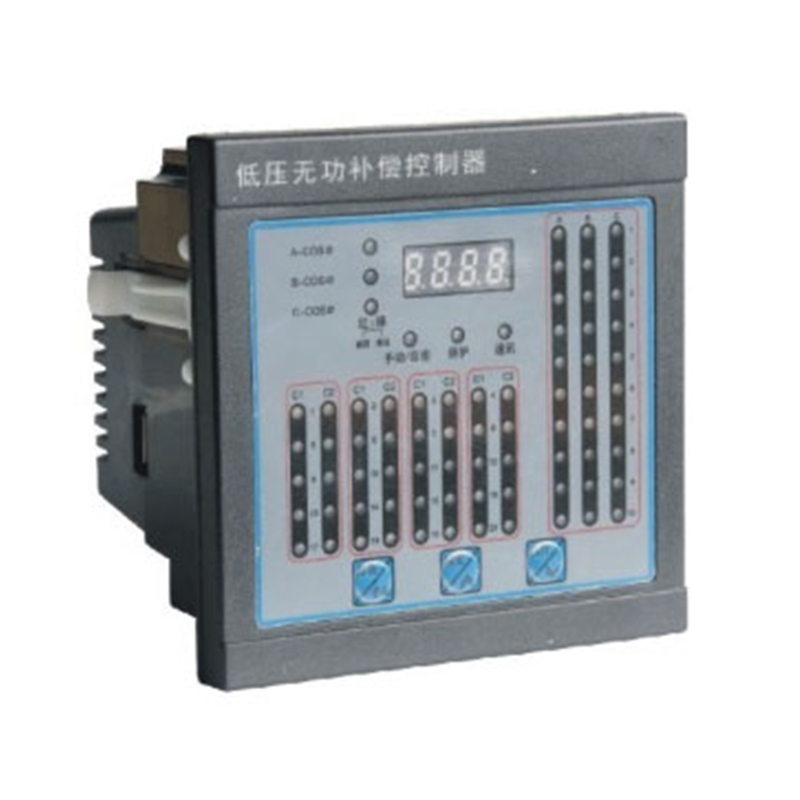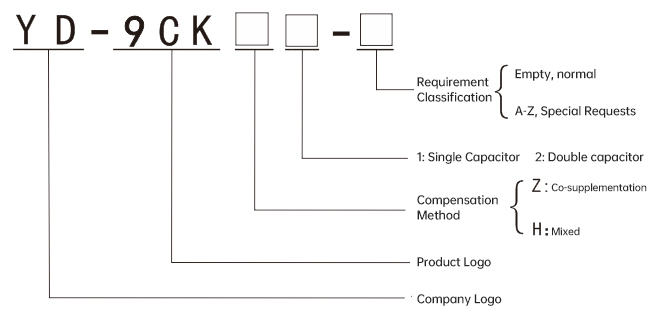Shared compensation is suitable for reactive power compensation in locations with balanced three-phase loads, and controls shared compensation intelligent capacitors.Features
1) AC sampling provides data such as voltage, current, and power factor.
2) Dynamically displays various power distribution parameter values, allowing for quick and easy parameter setting without losing settings during power outages.
3) Automatically detects capacitor quantity and capacity, controlling capacitor switching based on grid reactive power parameters.
4) Features overvoltage, undervoltage, voltage warning, voltage harmonics alarm, undercurrent, and overtemperature protection. When grid parameters exceed set limits, the controller quickly disconnects active capacitors and locks out the output, protecting capacitors for safe operation and extending their service life.
5) Integrated calculations are performed using voltage, current, power factor, and reactive power, with voltage hysteresis factor factored into control decisions, ensuring more accurate compensation and preventing switching oscillation.
6) Multiple sampling points are used within the action delay time to determine reactive power trends and flows, avoiding the erroneous judgments often associated with single-point sampling at conventional controllers. In situations with large power factor fluctuations, the controller accurately determines the required reactive power compensation and the compensation direction (on or off).
7) Manual/automatic switching function. In automatic mode, capacitors are switched on and off based on a combination of voltage, load, power factor, and reactive power shortage. In manual mode, capacitors can be manually switched on and off, facilitating factory commissioning and capacitor switching. Simulated switching can be performed in both manual and automatic modes.
8) Switching principle: Cyclic switching is used to extend capacitor life.
Operating Environment
Operating Temperature: -20°C-60°C
Relative Humidity: ≤90% (20°C)
Atmospheric Pressure: 79.5-106.5 kPa
Altitude: ≤2000 m
Protection Rating: IP30 - Panel IP40
Installation Environment: Indoor
Avoid the presence of flammable or explosive media, conductive dust, or corrosive gases.
Product Model:

Description: Hybrid compensation is suitable for reactive power compensation in locations with unbalanced three-phase loads, and controls both separate and shared compensation intelligent capacitors.
Shared compensation is suitable for reactive power compensation in locations with balanced three-phase loads, and controls shared compensation intelligent capacitors.Features
1) AC sampling provides data such as voltage, current, and power factor.
2) Dynamically displays various power distribution parameter values, allowing for quick and easy parameter setting without losing settings during power outages.
3) Automatically detects capacitor quantity and capacity, controlling capacitor switching based on grid reactive power parameters.
4) Features overvoltage, undervoltage, voltage warning, voltage harmonics alarm, undercurrent, and overtemperature protection. When grid parameters exceed set limits, the controller quickly disconnects active capacitors and locks out the output, protecting capacitors for safe operation and extending their service life.
5) Integrated calculations are performed using voltage, current, power factor, and reactive power, with voltage hysteresis factor factored into control decisions, ensuring more accurate compensation and preventing switching oscillation.
6) Multiple sampling points are used within the action delay time to determine reactive power trends and flows, avoiding the erroneous judgments often associated with single-point sampling at conventional controllers. In situations with large power factor fluctuations, the controller accurately determines the required reactive power compensation and the compensation direction (on or off).
7) Manual/automatic switching function. In automatic mode, capacitors are switched on and off based on a combination of voltage, load, power factor, and reactive power shortage. In manual mode, capacitors can be manually switched on and off, facilitating factory commissioning and capacitor switching. Simulated switching can be performed in both manual and automatic modes.
8) Switching principle: Cyclic switching is used to extend capacitor life.
Operating Environment
Operating Temperature: -20°C-60°C
Relative Humidity: ≤90% (20°C)
Atmospheric Pressure: 79.5-106.5kPa
Altitude: ≤2000m
Protection Level: IP30 - Panel IP40
Installation Environment: Indoor
No flammable or explosive media, conductive dust, or corrosive gases present.690V Version:
Product Model:
Description: Mixed compensation is suitable for reactive power compensation in three-phase unbalanced load locations, and controls both separate and shared compensation intelligent capacitors.
Shared compensation is suitable for reactive power compensation in three-phase balanced load locations, and controls shared compensation intelligent capacitors.
Features
1) Voltage, current, power factor, and other data are acquired through AC sampling.
2) Dynamically displays various power distribution parameter values, making parameter setting simple and quick, and settings are retained even after a power outage.
3) Automatically detects information such as the number and capacity of capacitors and controls capacitor switching based on grid reactive power parameters.
4) Features overvoltage, undervoltage, voltage warning, voltage harmonics warning, undercurrent, and overtemperature. When grid parameters exceed set limits, the controller quickly disconnects active capacitors and locks out the output, protecting capacitors for safe operation and extending their service life.
5) Utilizes comprehensive calculations of voltage, current, power factor, and reactive power, with voltage hysteresis factor factored into control decisions, ensuring more accurate compensation and preventing switching oscillation.
6) The above criteria are sampled at multiple points during the action delay period, and reactive power trends are determined based on the values at each point. This avoids the misjudgment caused by single-point sampling at the action point of conventional controllers. In situations with large power factor fluctuations, the required reactive power compensation and the compensation direction (on or off) can be accurately determined.
7) It features a manual/automatic switching function. In the automatic setting, capacitors are switched on or off based on a combination of factors: voltage, load, power factor, and reactive power shortage. In the manual setting, capacitors can be manually switched on or off, facilitating factory commissioning and switching capacitors. Simulated switching can be achieved in both manual and automatic modes.
8) Switching principle: Cyclic switching is used to extend capacitor life.
Operating Environment
Operating Temperature: -20°C-60°C
Relative Humidity: ≤90% (20°C)
Atmospheric Pressure: 79.5-106.5 kPa
Altitude: ≤2000 m
Protection Rating: IP30 - Panel IP40
Installation Environment: Indoors
Avoid the presence of flammable or explosive media, conductive dust, or corrosive gases. 





